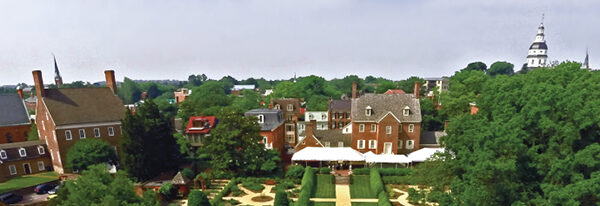More than Seventy Years of Historic Annapolis
Historic Annapolis grew out of a grassroots effort to preserve the outstanding architectural legacy of Maryland’s capital city. Since its inception in 1952, our organization has been instrumental in saving or protecting hundreds of historic buildings in the heart of the city. We’ve helped to block outsized new construction that would have detracted from the city’s historic character and special charm. Annapolis is now a revitalization success story in which preservation of its unique historical identity has contributed to a thriving economy and high quality of life.
For more than six decades, Historic Annapolis has also researched, chronicled, and interpreted the many facets of Annapolis’s diverse history. We’ve collected documents, images, and artifacts that embody that history. And we’ve made that history accessible and enjoyable through a wide range of educational opportunities and public programs.
This timeline highlights just a few of the key preservation initiatives in which Historic Annapolis has played a major role and a sampling of the educational programs we have launched.
1952
Historic Annapolis, Inc. (later renamed Historic Annapolis Foundation, and now Historic Annapolis) was formed when concerned citizens joined efforts to safeguard their city’s historic structures and character.
1953
The organization began developing public education programs to encourage appreciation of the city’s historical, architectural, and cultural assets.
1955
Historic Annapolis’s first major project raised funds to move the Charles Carroll the Barrister House from its original site on Main Street to the campus of St. John’s College to save it from demolition.
1957
When Shiplap House (18 Pinkney Street), one of the city’s earliest buildings, was threatened with demolition, Historic Annapolis purchased it. Once restored, the building housed the organization’s main office for many years.
1959
Historic Annapolis undertook the first of three comprehensive building surveys to identify and call attention to the scope of the city’s architectural assets.
1960
The organization’s research center was established.
1962
Historic Annapolis led the campaign to prevent the U.S. Naval Academy’s expansion into “Three Ancient Blocks” just outside Gate 3.
1963
A Revolving Fund was begun to enable the purchase, renovation, and resale of historic structures with protective easements in place.
1965
Historic Annapolis raised $276,000 to acquire the colonial-era William Paca House, then barely recognizable at the core of the outmoded Carvel Hall hotel. The State of Maryland purchased the rest of the hotel property, once the location of Paca’s garden. Research and restoration work began to return the Paca site to its original appearance.
The Colonial Annapolis Historic District was designated a National Historic Landmark.
1967
Historic Annapolis negotiated federal and state grants that enabled it to buy 77 Main Street and 4 & 43 Pinkney Street and to establish protective easements on Middleton Tavern and 37 Cornhill Street.
1969
Historic Annapolis launched its Historic Building Marker program as a means to promote preservation and educate people about the city’s diverse architectural heritage.
In collaboration with Friends of the Market, Historic Annapolis rallied public support needed to rescue the 1858 Market House at City Dock from plans for demolition to clear the way for a parking facility. The effort also mobilized support needed to approve the Historic District Ordinance, granting greater protections for historic structures through oversight by the city government’s Historic District Commission (now Historic Preservation Commission).
1972
Historic Annapolis was instrumental in winning a reprieve from proposed demolition for fourteen threatened buildings on State Circle.
1974
The William Paca Garden opened to the public following years of restoration work.
1976
The restored William Paca House opened to the public in time for the nation’s Bicentennial celebration.
1978
Historic Annapolis supported the Annapolis City Council’s passage of a Height and Bulk Ordinance and a Demolition by Neglect Ordinance, strengthening protection of the historic district’s existing buildings and human scale.
1980
Historic Annapolis’s museum and public programs were accredited by the American Association of Museums (now the American Alliance of Museums).
1981
Historic Annapolis trademarked the phrase “Annapolis: A Museum Without Walls.”
1982
Archaeology in Annapolis, a program jointly sponsored by Historic Annapolis, the City of Annapolis, and the University of Maryland, College Park, excavated the first of many city sites. Over the years, the project’s research findings have added greatly to our understanding of the city’s past.
1984
Annapolis’s historic district was added to the National Register of Historic Places.
1988
After lengthy negotiations, Historic Annapolis won adherence to height regulations in the construction of a parking garage in the historic district.
1991
Discoveries made by Archaeology in Annapolis at the Maynard-Burgess House and the Charles Carroll House revealed much about African Americans in Annapolis and attracted national media attention.
1992
Historic Annapolis presented its first “Annapolis by Candlelight” tour of historic homes, launching one of the city’s most popular annual events.
1994
The successful advocacy of Historic Annapolis and the city’s Historic Preservation Commission resulted in restoration of the 19th-century Anne Arundel County Courthouse on Church Circle as the entrance to a new court facility.
1995
Following intense lobbying by Historic Annapolis, Main Street was reconstructed with brick pavement, and power and telephone lines were placed underground.
1998
Historic Annapolis helped to organize the Vernacular Architecture Forum conference “The Chesapeake Landscape” and contributed to the resulting book Architecture in Annapolis: A Field Guide.
2002
Historic Annapolis celebrated its 50th anniversary.
2005
The National Trust for Historic Preservation named Annapolis one of “America’s Dozen Distinctive Destinations.”
2006
At 99 Main Street, Historic Annapolis opened HistoryQuest (now the Museum of Historic Annapolis) at the St. Clair Wright Center as a facility to orient visitors to the history of Maryland’s capital city.
2009
Historic Annapolis began its “Footprints” afterschool educational enrichment program for students in local Title I elementary schools.
2011
Historic Annapolis researched, wrote, and produced “Project Run-A-Way,” a living history stage show that dramatized the stories of nine runaway servants and slaves. The show was presented at four theaters across Maryland.
2013
The exhibit “Freedom Bound: Runaways of the Chesapeake” opened at the Historic Annapolis Museum and Store, with satellite components at the Waterfront Warehouse and the Banneker-Douglass Museum.
2014
The State of Maryland purchased the colonial–era James Brice House and arranged for Historic Annapolis to maintain and manage it.
2015
Historic Annapolis becomes a Smithsonian Affiliate, one of just over 200 Affiliates in the country, and one of only six in the State of Maryland.
2016
Historic Annapolis begins a multi-year, state-of-the-art restoration of the James Brice House.
2018
Historic Annapolis began leading the discussion about working toward a preservation-based treatment for Annapolis City Dock.
2020
Historic Annapolis completes a $500,000 restoration of the building at 99 Main Street to prepare for the installation of the new exhibit about the history of Annapolis.
2021
Historic Annapolis opens the new exhibition, Annapolis: An American Story at the Museum of Historic Annapolis at 99 Main Street. This exhibition shares the chronological history of Annapolis across 400 years, and features a city-wide heritage tourism experience, with 10 additional partner sites located throughout the city.


